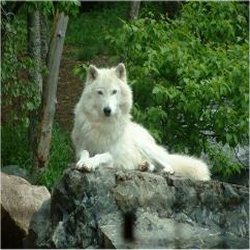 The Arctic is no place for the weak. In this harsh and often cruel environment only the strongest will survive. One of the few animals that calls this forbidden land home is the arctic wolf. Often called the white wolf or the tundra wolf this magnificent animal is well suited to living in the north.
The Arctic is no place for the weak. In this harsh and often cruel environment only the strongest will survive. One of the few animals that calls this forbidden land home is the arctic wolf. Often called the white wolf or the tundra wolf this magnificent animal is well suited to living in the north.
Arctic wolves can go for weeks without food.
Predators in the north cannot afford to be choosey. Prey is often scarce and meals are often infrequent and small. Arctic wolves will hunt almost anything in the north. They will hunt and eat, arctic hare, lemmings, birds, and caribou. Musk ox and seals have also been to known to become a meal for a hungry wolf pack.
Wolves will often following the migrating caribou herds.
Wolves eat all of the kill including the bones. The alpha male always eats first and then stands guard while the alpha female has her meal.
The arctic wolf can survive in sub zero temperatures for months on end. They are also accustomed to the long dark winter months.
Arctic wolves usually live in packs. A pack can be anywhere from two to thirty animals.
The arctic wolf is one of the few animals that still roams over all of its original territory. Wolves will roam over huge distances to find prey. Their natural hunting grounds are the northern most islands of Canada, parts of Alaska and Greenland.
It is believed that the wolves migrated over the ice to Greenland.
Scientists have learned a great deal about the life and habits of wolves from the arctic wolf. One of the main reasons for this is that arctic wolves tend to be more curious than afraid of humans. This is probably due to the lack of previous contact between the two species.
Arctic wolves will dig a den in the snow to have their puppies. If the ice is too hard they will seek a cave or a rocky area. If none of these things is available they will have the pups out in the open. The puppies are usually born in May or June. An arctic wolf will usually have betrween two to six puppies. The entire pack helps to feed the litter.
Arctic wolf pups are a yellowish color. Their coat gradually gets whiter as they age.
Arctic wolves are the only kind of wolf that is not considered to be endangered. Although their numbers are not large, scientists do not consider them to be in any danger. One of the primary reasons for this, is the fact that even the Inuit live for the most part further south than they do. Their territory is virtually untouched.
Arctic wolves are slightly smaller than their grey cousins. The average male wolf will grow to be about three feet high and will weigh between 75 and 150 lbs. Wolves in the wild have a much shorten life expectancy, only about seven years, compared to a captive wolf which may live closer to twenty.
Google+